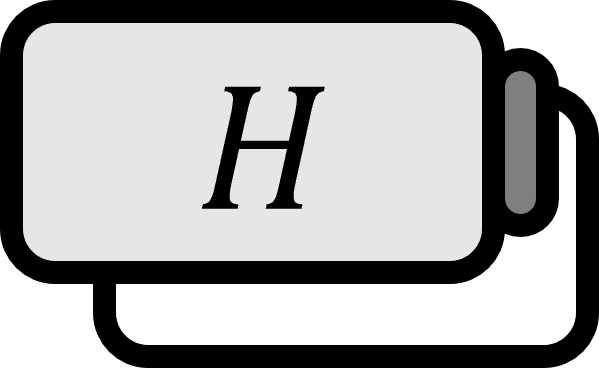Properties of the Norm Associated with the Inner Product Defined in Inner Space
Theorem1
Given an inner space $\left( X, \langle \cdot,\cdot \rangle \right)$, one can naturally define the [norm] as in $\left\| \cdot \right\|:=\sqrt{\left\langle \cdot,\cdot \right\rangle }$ and the following properties hold.
(a) The Cauchy-Schwarz Inequality: For any $\mathbf{x}, \mathbf{y}\in X$,
$$ \left| \langle \mathbf{x},\mathbf{y} \rangle \right| \le \left\| \mathbf{x} \right\| \left\| \mathbf{y} \right\| $$
(b) The Parallelogram Law: For any $\mathbf{x},\mathbf{y}\in X$,
$$ \left\| \mathbf{x} + \mathbf{y} \right\|^{2} + \left\| \mathbf{x} - \mathbf{y} \right\|^{2} = 2 \left( \left\| \mathbf{x} \right\| ^{2}+ \left\| \mathbf{y} \right\| ^{2} \right) $$
(c) The polarization identity in a complex vector space: In a complex inner space $X$ and for any $\mathbf{x},\mathbf{y}\in X$,
$$ \langle \mathbf{x},\mathbf{y} \rangle = \frac{1}{4} \Big( \left\| \mathbf{x} + \mathbf{y} \right\|^{2} - \left\| \mathbf{x} - \mathbf{y} \right\|^{2} + i \left( \left\| \mathbf{x} + i\mathbf{y} \right\|^{2} - \left\| \mathbf{x} - i\mathbf{y} \right\|^{2} \right) \Big) $$
(d) The polarization identity in a real vector space: In a real inner space $X$ and for any $\mathbf{x},\mathbf{y}\in X$,
$$ \langle \mathbf{x},\mathbf{y}\rangle = \frac{1}{4} \left( \left\| \mathbf{x}+\mathbf{y} \right\|^{2} - \left\| \mathbf{x}-\mathbf{y} \right\| ^{2} \right) $$
(e) Norm versus inner product: For any $\mathbf{x} \in X$,
$$ \left\| \mathbf{x} \right\| =\sup \left\{ \left| \langle \mathbf{x},\mathbf{y} \rangle \right| : \mathbf{y}\in X, \left\| \mathbf{y} \right\| =1 \right\} $$
Proof
(a)
In an inner space, by the definition of norm, the Cauchy-Schwarz inequality is
$$ \begin{align*} \left| \langle \mathbf{x},\mathbf{y}\rangle \right| & \le \langle \mathbf{x},\mathbf{x} \rangle^{1/2} \langle \mathbf{y},\mathbf{y} \rangle ^{1/2} \\ =&\ \left\| \mathbf{x} \right\| \left\| \mathbf{y} \right\| \end{align*} $$
■
(b)
$$ \begin{align*} \left\| \mathbf{x} + \mathbf{y} \right\|^{2} + \left\| \mathbf{x} - \mathbf{y} \right\|^{2} =&\ \langle \mathbf{x}+\mathbf{y}, \mathbf{x}+\mathbf{y}\rangle + \langle \mathbf{x}-\mathbf{y},\mathbf{x}-\mathbf{y} \rangle \\ =&\ \langle \mathbf{x},\mathbf{x} \rangle + \langle \mathbf{x},\mathbf{y}\rangle + \langle \mathbf{y},\mathbf{x} \rangle + \langle \mathbf{y},\mathbf{y} \rangle \\ & + \langle \mathbf{x},\mathbf{x} \rangle -\langle \mathbf{x},\mathbf{y}\rangle -\langle \mathbf{y},\mathbf{x} \rangle + \langle \mathbf{y},\mathbf{y} \rangle \\ =&\ 2 \langle \mathbf{x},\mathbf{x} \rangle + 2 \langle \mathbf{y},\mathbf{y} \rangle \\ =&\ 2 \left(\langle \mathbf{x},\mathbf{x} \rangle + \langle \mathbf{y},\mathbf{y} \rangle \right) \\ =&\ 2 \left( \left\| \mathbf{x} \right\|^{2} + \left\| \mathbf{y} \right\|^{2} \right) \end{align*} $$
■
(c)
Referencing the proof of (b), one can obtain the calculation result for the real part.
$$ \begin{align*} \left\| \mathbf{x} + \mathbf{y} \right\|^{2} -\left\| \mathbf{x} - \mathbf{y} \right\|^{2} =&\ 2 \langle \mathbf{x},\mathbf{y}\rangle + 2 \langle \mathbf{y},\mathbf{x}\rangle \end{align*} $$
Calculating the imaginary part yields:
$$ \begin{align*} \left\| \mathbf{x} + i\mathbf{y} \right\|^{2} =&\ \langle \mathbf{x}+i\mathbf{y} , \mathbf{x}+i\mathbf{y} \rangle \\ =&\ \langle \mathbf{x},\mathbf{x}\rangle + \langle \mathbf{x},i\mathbf{y}\rangle + \langle i\mathbf{y},\mathbf{x}\rangle +\langle i\mathbf{y},i\mathbf{y}\rangle \\ =&\ \langle \mathbf{x},\mathbf{x}\rangle -i\langle \mathbf{x},\mathbf{y}\rangle + i\langle \mathbf{y},\mathbf{x}\rangle +\langle \mathbf{y},\mathbf{y} \rangle \end{align*} $$
And
$$ \begin{align*} \left\| \mathbf{x} - i\mathbf{y} \right\|^{2} =&\ \langle \mathbf{x}-i\mathbf{y} , \mathbf{x}-i\mathbf{y}\rangle \\ =&\ \langle \mathbf{x},\mathbf{x}\rangle - \langle \mathbf{x},i\mathbf{y}\rangle - \langle i\mathbf{y},\mathbf{x}\rangle +\langle i\mathbf{y},i\mathbf{y}\rangle \\ =&\ \langle \mathbf{x},\mathbf{x}\rangle +i\langle \mathbf{x},\mathbf{y}\rangle -i\langle \mathbf{y},\mathbf{x}\rangle +\langle \mathbf{y},\mathbf{y} \rangle \end{align*} $$
Therefore
$$ \left\| \mathbf{x} + i\mathbf{y} \right\|^{2} - \left\| \mathbf{x} - i\mathbf{y} \right\|^{2} = -2i \langle \mathbf{x},\mathbf{y} \rangle +2i\langle \mathbf{y},\mathbf{x} \rangle $$
Thus
$$ \begin{align*} & \left\| \mathbf{x} + \mathbf{y} \right\|^{2} - \left\| \mathbf{x} - \mathbf{y} \right\|^{2} + i \left(\left\| \mathbf{x} + i\mathbf{y} \right\|^{2} - \left\| \mathbf{x} - i\mathbf{y} \right\|^{2} \right) \\ =&\ 2 \langle \mathbf{x},\mathbf{y} \rangle + 2 \langle \mathbf{y},\mathbf{x} \rangle +2\langle \mathbf{x},\mathbf{y} \rangle -2 \langle \mathbf{y},\mathbf{x} \rangle \\ =&\ 4 \langle \mathbf{x},\mathbf{y} \rangle \end{align*} $$
■
(d)
If $\langle \mathbf{x},\mathbf{y} \rangle \in \mathbb{R}$ then $\langle \mathbf{x},\mathbf{y} \rangle=\overline{\langle \mathbf{y},\mathbf{x} \rangle}=\langle \mathbf{y},\mathbf{x} \rangle$, thus
$$ \begin{align*} \left\| \mathbf{x} + \mathbf{y} \right\| ^{2} -\left\| \mathbf{x} - \mathbf{y} \right\| ^{2} =&\ 2 \langle \mathbf{x},\mathbf{y}\rangle + 2 \langle \mathbf{y},\mathbf{x}\rangle \\ =&\ 4\langle \mathbf{x},\mathbf{y} \rangle \end{align*} $$
■
(e)
By the Cauchy-Schwarz inequality,
$$ \left| \left\langle \mathbf{x},\mathbf{y} \right\rangle \right| \le \left\| \mathbf{x} \right\| \left\| \mathbf{y} \right\| $$
Then the following equation holds:
$$ \sup \limits_{\left\| \mathbf{y} \right\|=1 } \left| \left\langle \mathbf{x},\mathbf{y} \right\rangle \right| \le \left\| \mathbf{x} \right\| $$
At this time, if $\mathbf{y}=\dfrac{\mathbf{x}}{\left\| \mathbf{x} \right\| }$ is taken as $\left\| \mathbf{y} \right\| = 1$, then
$$ \begin{align*} \left| \left\langle \mathbf{x},\mathbf{y} \right\rangle \right| =&\ \left| \left\langle \mathbf{x}, \frac{\mathbf{x}}{\left\| \mathbf{x} \right\| } \right\rangle \right| \\ =&\ \frac{1}{\left\| \mathbf{x} \right\| } \left\langle \mathbf{x},\mathbf{x} \right\rangle \\ =&\ \frac{1}{\left\| \mathbf{x} \right\| }\left\| \mathbf{x} \right\|^{2} \\ =&\ \left\| \mathbf{x} \right\| \end{align*} $$
is satisfied, therefore
$$ \sup \limits_{\left\| \mathbf{y} \right\|=1 } \left| \left\langle \mathbf{x},\mathbf{y} \right\rangle \right| = \left\| \mathbf{x} \right\| $$
■
Ole Christensen, Functions, Spaces, and Expansions: Mathematical Tools in Physics and Engineering (2010), p64-65 ↩︎
